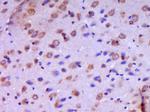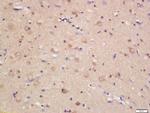Search Thermo Fisher Scientific
FIGURE: 1 / 2
JAMC Antibody (BS-11086R) in IHC (P)


Product Details
BS-11086R
Species Reactivity
Host/Isotype
Class
Type
Immunogen
Conjugate
Form
Concentration
Purification
Storage buffer
Contains
Storage conditions
Shipping conditions
Target Information
JAM3 is involved in tight junctions and represent one mode of cell-to-cell adhesion in epithelial or endothelial cell sheets, forming continuous seals around cells and serving as a physical barrier to prevent solutes and water from passing freely through the paracellular space. The protein encoded by this immunoglobulin superfamily gene member is localized in the tight junctions between high endothelial cells. Unlike other proteins in this family, the this protein is unable to adhere to leukocyte cell lines and only forms weak homotypic interactions. The encoded protein is a member of the junctional adhesion molecule protein family and acts as a receptor for another member of this family.
For Research Use Only. Not for use in diagnostic procedures. Not for resale without express authorization.
References (0)
Bioinformatics
Protein Aliases: JAM-2; JAM-3; JAM-C; junction cell adhesion molecule 3; junction cell adhesion molecule C; Junctional adhesion molecule 3; Junctional adhesion molecule C
Gene Aliases: 1110002N23Rik; JAM-2; JAM-3; JAM-C; JAM3; JAMC; Jcam3; UNQ859/PRO1868
UniProt ID: (Human) Q9BX67, (Mouse) Q9D8B7, (Rat) Q68FQ2
Entrez Gene ID: (Human) 83700, (Mouse) 83964, (Rat) 315509

Performance Guarantee
If an Invitrogen™ antibody doesn't perform as described on our website or datasheet,we'll replace the product at no cost to you, or provide you with a credit for a future purchase.*
Learn more
We're here to help
Get expert recommendations for common problems or connect directly with an on staff expert for technical assistance related to applications, equipment and general product use.
Contact tech support
